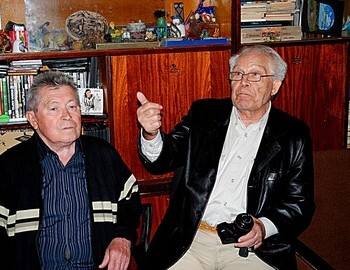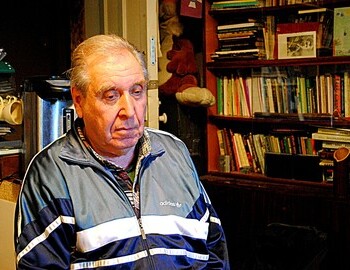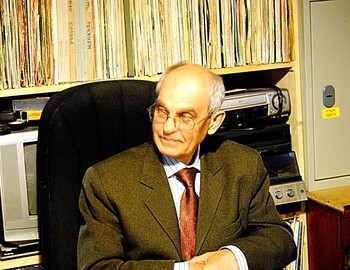
Interview with members of the 1959 search group
Vladimir Mihaylovich Askinadzi, Valentin Gerasimovich Yakimenko, Evgeniy Grigorievich Zinovyev, Pyotr Ivanovich Bartolomey. June 2013. (taina.li)
I would like to warn you right away that this interview does not contain any sensational materials, it only clarifies and supplements some details concerning both the equipment and practices of the Dyatlov group, issues of material support and supplies for the group. In addition, without voicing anyone's versions, general issues concerning search operations, relationships both within the group itself and public opinion of those years, as well as general hiking practices of the fifties and sixties of the last century will be briefly covered.
Since the interview itself had the character of free exchange, and not a dialogue between two people, I decided to group the questions by topic and present them in non-chronological order, since in addition, outside this conversation questions were sent to me by Mr. Rokotyan and Mrs. Kirillova.
1. Questions concerning the tactics of the group.
WeiS: Do you think that the Dyatlov group was behind schedule on the route? (meaning late starts, long sleep, night conversations until 3:00)
Askinadzi, Bartolomey, Zinovyev, Yakimenko: The route of the Dyatlov group was to some extent a gift of fate for them, first moving along a beaten path, then along а Mansi hunter ski track, only the last day of the movement turned out to be difficult and tense. Because of this, the leader of the expedition and the group felt at ease. On my own behalf, I will note that none of those present expressed any doubts about the possibility of reaching Otorten from the place of the last stop and returning back within one day.
2. Questions about the group's equipment.
WeiS: Please tell us about the stove's design and its features.
Bartolomey, Yakimenko: The stove was in the form of a parallelepiped, with a pipe mounted at the end. The pipe was collapsible and had protection to preserve the tent wall in the form of a ring on the pipe, made of an asbestos sheet, as well as an additional ring of longitudinal wooden bars, fastened with wire or cord. These raw bars were usually prepared and fastened on site. The stove was loaded approximately once an hour, to one third of its height, with specially chopped logs 30-40 cm long and 4-6 cm in diameter. That is, it was no different from later stoves, neither in design nor in the practice of use. It is worth noting that there were no partitions inside this stove, and there was no spark arrestor on the pipe. The stove was suspended on a metal cable, which significantly increased the number of places to sleep in the tent. The tent itself had no protection against sparks (unlike later models). It was common practice to load the stove with firewood to save space.
According to all those present, the Dyatlov group was not going to light the stove either in the evening or in the morning. And the firewood inside the stove and the log in the tent were intended for dinner and heating after returning from Otorten. That is, breakfast and dinner with dry rations were planned for the evening and morning. A hot lunch was planned on the approach to Otorten, since there was firewood there. A hot dinner was planned upon returning from Otorten.
WeiS: Tell us about the peculiarities of water supply for hiking groups and in particular what applied to the Dyatlov group?
Askinadzi, Zinovyev: The usual practice was to use rubber medical hot-water bottles with cocoa, snow was melted on a fire or stove, sometimes it was stuffed into hot-water bottles and melted on the body (in the stomach area). The searchers confirmed the presence of three flasks, including one with alcohol. Mr. Slobtsov drank it. In addition, the presence of flasks made of synthetic materials, which appeared two years later, was completely excluded.
Question: But the materials of the Criminal Case do not describe any hot water bottles?
Askinadzi: The materials of the Criminal Case do not describe a lot of things!
WeiS: Did the group have plywood or tools for deepening the tent? If not, what items were used for this purpose?
Yakimenko, Zinovyev: There were no special snow tools, they dug, as a rule, with skis, sometimes with pots and buckets.
Replica of the stove, Alexander Fedotov, February 2025
- 2 -
3. Some aspects of the search operation
(exchange of information and clarifications between all participants in the search operation).
Weiss: What was the condition of the snow in the area of the "den" and in the area where the bodies of the last "four" of the dead were found? Were there remains of a fire in the area of the den?
Answer: The depth of the snow at the site where the den was found was about three meters, the snow above the den was practically undifferentiated in layers, it seemed that the den was simply buried under the drifting snow. It was emphasized that the den was found along a "path" of pine needles and small twigs, and this trail sharply went down at an angle to the stream. The snow above the deceased was wet, had no structural changes, was undifferentiated, was removed with snow scoop shovels, its depth was less than a meter. None of the searchers noticed traces of a fire in the ravine. There were no changes in the color of the snow in the area of the den or the bodies.
WeiS: How and in what way were the bodies identified at the site? How were they removed?
Askinadzi: Lyudmila Dubinina was identified by her hair, when removing her from the water where she was found, we carried and laid her face down. I learned about the absence of her tongue only a month and a half later, already in Sverdlovsk. As for the other bodies, they were removed and carried by soldiers, but Mr. Zinovyev, for example, saw metal teeth on Zolotaryov. No stretchers or even poles were used to carry the bodies - they were carried by holding the body by the clothes, and according to Askinadzi's observation: "the meat was already separating from the bones." As for the body of Zolotaryov, according to those present, no one identified it, and the forensic expert was guided only by the age characteristics inherent in older people.
The story of Askinadzi about the notebook in Semyon Zolotaryov's hand is interesting: "The notebook was in his hand folded with the pages outward, so that its cover was impossible to see, there were no notes on the open pages, but the pages were not torn out either, the book was positioned along the curvature of Zolotaryov's palm, in his right hand there was a pencil. But the type of pencil, unfortunately, is unknown. The pages of the notebook were wet."
WeiS: What were the reasons for the helicopter pilots' refusal to transport the bodies? Just their condition or some other reasons?
Askinadzi: The helicopter pilots refused to transport the bodies only because they were not properly packed; they were forbidden to do so by instructions. Because of this, I walked around the entire camp and collected liners (for sleeping bags - ed. note), later they brought bags and the problem was resolved.
WeiS: Why are you sure that there were no strangers at the scene of the tragedy except for the Dyatlov group?
Askinadzi: Since the bodies of four people were not found immediately after the tent was discovered, one of the versions of the prosecutor's investigator Ivanov was the assumption that this foursome, better dressed and "warmed up", left the crash site. The objections of the searchers, including Askinadzi that people without skis could not have gone far, and that this foursome should be looked for no further than 1000-1500 m from the camp, were not accepted by the investigator. A large area was inspected, in particular the Otorten area, where no traces of human presence were found.
WeiS: Tell us how prosecutor investigator Ivanov behaved? What did he say?
Askinadzi: Upon arrival in Ivdel, Ivanov came to our dormitory, showed us the cut tent, asked a lot of questions, and seemed to be somewhat confused, since he could not understand at all what had happened. His behavior changed dramatically after being summoned to Moscow (it is worth noting that Ivanov was leaving for Sverdlovsk with Kikoin, and the searchers, including Askinadzi, did not know about his summons to Moscow). It is interesting that Ivanov promised to provide Askinadzi film from Igor Dyatlov's camera, but he never fulfilled his promise, which, however, can be explained by the fact that these films were included in the materials of the criminal case.
- 3 -
4. Personal relationship issues in the Dyatlov Group
WeiS: Can we consider that Semyon Zolotaryov joining the group at the last moment was a mistake? He is a new person, no one knows him, they don't know if they are going to get along and nothing about his hiking experience.
Askinadzi, Bartolomey: Of course, introducing a new person in the group has a certain risk, but in this case, based on the diary entries and photographs, we can conclude that Semyon Zolotaryov joined the group without any problems. As for the photographs (meaning letters from both forum participants and simply people interested in this problem to Askinadzi), where it is indicated that Zolotaryov "looks somehow wrong, he has an angry face ...", I can answer with a counter question: "Have you seen your face after a climb on a difficult day?" Indeed, these photographs refer to the last (and incredibly difficult) day, so the facial expressions in the photographs are quite normal. Since the people in the group were already been on treks together and familiar with each other, the searchers consider a conflict between Dyatlov and Zolotaryov unlikely, including because of the personality of Igor Dyatlov himself, who was a strong leader. In addition, the fact that Thibeaux-Brignolle and Zolotaryov clearly had good relations is noteworthy, which suggests that Zolotaryov was clearly not an "outsider" in the group.
I hope this interview will help you in your further research.
I would like to thank Ms. Kirillova and Mr. Rokotyan for participating in the conversation described above, and I hope that they will publish their interview, since their questions were extremely interesting.
I would like to express special gratitude to Yuri Konstantinovich Kuntsevich, Helga and Alina, who organized this interview.
This is my first interview in my life, so please do not judge me harshly.
Additions to the interview from June 8, 2013.
These questions, although they were not asked by me or other correspondents, arose spontaneously during the conversation, and since they are of undoubted interest, I nevertheless decided to add them after some reflection and not without the help of Yuri Konstantinovich Kuntsevich. Since all searchers took part in the conversation, the authorship of both questions and answers is not indicated.
Question: What versions did the participants in the search operation favor and what did they say about the Dyatlov group tragedy in Sverdlovsk?
Answer: There were many versions, but basically, especially in Sverdlovsk, the missile testing was most popular.
Question: How tactically correct was the overnight location on the slope of height 1079 on February 1, 1959?
Answer: Considering that the tent was set up according to all the rules, stretched out, skis were placed under it, and the tent itself was dug in, and a snow wall was made on the windward side, the decision to spend the night in this place should be considered correct and tactically advantageous, since on the way out to Otorten along the ridge and on the way back the tent is clearly visible on the slope, is sufficiently protected from the wind, and the second night in it would not be "cold".
Vera Kirillova: Did you see Kikoin during the search? Was he engaged in any measurements of the radioactive background or similar research?
Askinadzi: I saw Kikoin on the pass for two days, before his departure to Sverdlovsk, he was engaged in search work with a group of climbers.
Bartolomey: That's right, I was in his group, which he assembled from UPI students, we were also on search work for 2 days, only earlier. I myself did not see any devices, but then I found out that the device was there after all. This device (we are currently investigating its authorship) was designed before 1957 and had characteristics that exceeded the parameters of military dosimetric devices, so its author was involved in reconnaissance of the boundaries of the East Ural radioactive trace zone. The device was given by the author to Abram Konstantinovich Kikoin, who worked with it, mainly on the slope of height 1079.
When I asked whether these studies were conducted before radioactive dust was found on the boys' clothes or after, Pyotr Ivanovich said that he found it difficult to answer and was currently working on this issue himself.






